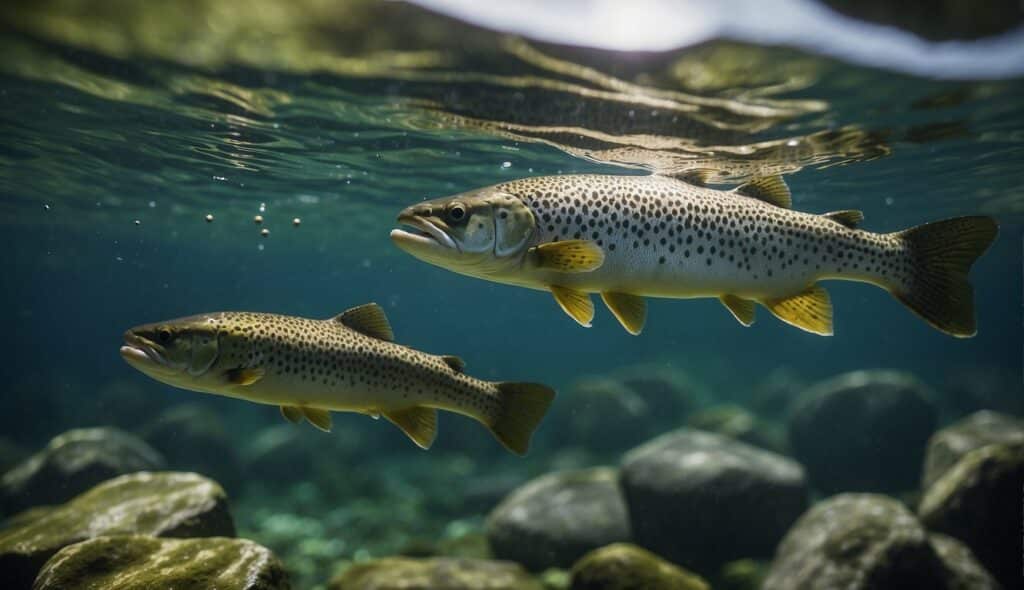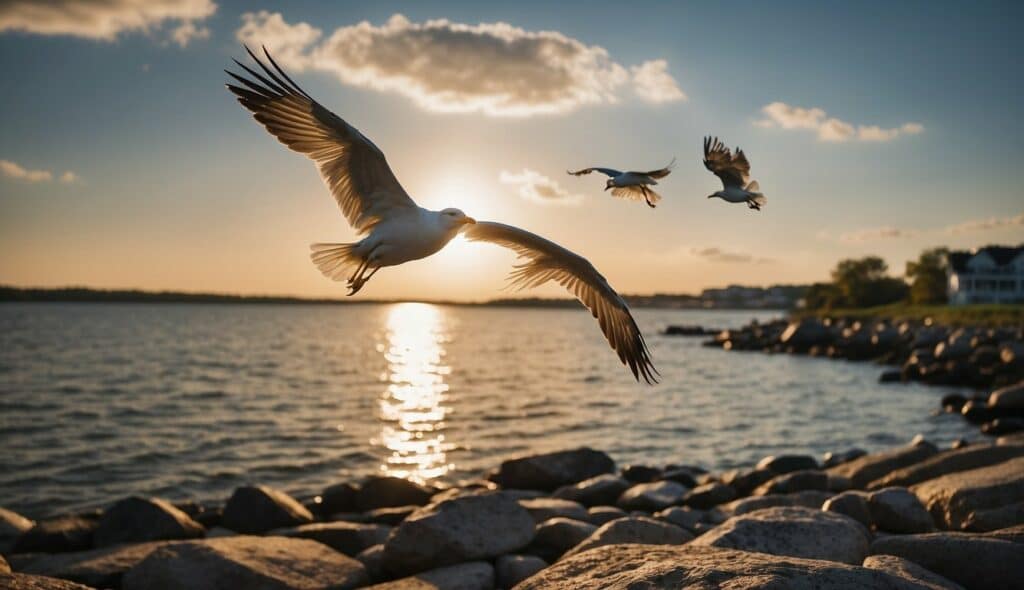Trout fishing is a rewarding activity that offers both challenge and serenity to those who partake in it. No matter if you’re a seasoned angler or someone new to the sport, understanding the fundamentals of trout fishing can greatly increase your chances of success. These freshwater fish are found in various habitats, from clear, fast-moving streams to deep, still lakes. To effectively target trout, you need to tailor your techniques to these diverse environments.
Understanding Trout Species
In exploring trout fishing, it’s essential to recognize the various trout species and their unique habits to improve your success rate in angling.
Characteristics of Common Trout Species
Each trout species possesses distinctive markings and body shapes that aid in their identification:
- Brook Trout (Salvelinus fontinalis): Often vibrant, with a greenish to brownish body dotted with distinctive red spots surrounded by blue halos. They have a marble-patterned back and a distinctive red or orange underbelly, especially during spawning.
- Brown Trout (Salmo trutta): Exhibiting brown to yellowish-brown coloration with black and red-orange spots, these fish can adapt to various habitats, making them a common catch.
- Rainbow Trout (Oncorhynchus mykiss): Known for their unique pink to red lateral stripe, these trout have a blue-green or yellow-green body speckled with black spots, extending to the tail.
- Cutthroat Trout (Oncorhynchus clarkii): This species stands out with red to orange slash marks on the underside of their lower jaw. They come in a variety of colors and patterns, depending on their habitat.
- Lake Trout (Salvelinus namaycush): With a more elongated body, these trout have light spots on a darker background, ranging from green to greyish colors.
- Bull Trout (Salvelinus confluentus): Closely related to the brook trout but larger, bull trout have a more slender body with smaller, more sparse spots.
For more detailed descriptions and visual aids, a comprehensive guide to trout identification is invaluable, such as Trout Species: A Comprehensive Guide to Identification and Characteristics.
Habitats of Trout
Understanding the preferred habitats of trout is crucial to locating them:
- Brook Trout: Thrive in clear, cold, and oxygen-rich waters, often found in remote, unpolluted streams.
- Brown Trout: These adaptable fish can be found in both rivers and lakes, favoring cooler temperatures and structures such as undercut banks for shelter.
- Rainbow Trout: Prefer fast-flowing streams and clean rivers, but they are also commonly stocked in lakes.
- Cutthroat Trout: Usually inhabit clear, cold, and moderately deep rivers and lakes, typically in the western United States.
- Lake Trout: True to their name, these fish are found in deep, cold, and oligotrophic lakes.
- Bull Trout: Require very cold and clean water, often residing in deeper pools and runs in rivers and lakes in the Pacific Northwest.
Learn more about trout behavior and habitat preferences, including Catch More Trout by Understanding Trout Species Behavior.
Essential Fishing Gear
To successfully fish for trout, it’s crucial to have the right gear optimized for the task. This means selecting a proper rod and reel, using the ideal line, leaders, and hooks, and choosing effective bait and lures.
Selecting the Right Rod and Reel
Your choice in fishing rod should be tailored to the type of trout fishing you plan to do. For most situations, an ultralight spinning rod paired with a spinning reel is effective, providing the sensitivity needed for detecting light trout bites and the strength for playing the fish. The length should generally be around 6 feet, to offer good casting ability without sacrificing control. Explore fishing gear that will serve you well in your trout catching endeavors.
Line, Leaders, and Hooks
Fishing line: Opt for a monofilament or fluorocarbon line with a test between 2-6 pounds for the best balance of visibility and strength. Leaders should be long enough to remain invisible to trout, typically around 9-12 feet, with fluorocarbon being a preferred choice for its lower visibility.
Hooks: A variety of hooks are necessary for different trout setups:
- For bait fishing: single hooks, size 8-14
- For nymphs and streamers in fly fishing: sizes suited to the pattern, typically 10-20
Choosing the Best Bait and Lures
When selecting bait and lures, consider the trout’s natural diet and the current conditions. Best lures for trout often include:
- Spinners and spoons: These mimic small fish and can be highly effective, especially silver or gold spoons for light reflection.
- Flies: When fly fishing, use a selection of nymphs, streamers, and surface flies to match the insects trout feed on.
Remember to tailor your choice of tackle to the trout species and the specific water you are fishing in.
Preparation for Fishing

Before setting out on a trout fishing adventure, it’s crucial to understand the environment, adapt to seasonal variations in trout behavior, and ensure you comply with local fishing regulations. This groundwork will set you up for a productive outing.
Reading the Water
Rivers and Streams: Focus on segments where the current slows, as trout often reside in these areas to conserve energy while waiting for food. Look for eddies, pools, and riffles, as these structures can be indicative of trout habitats.
- Cover: Consider areas with natural cover like rocks, logs, or overhanging vegetation. Trout use such cover for protection against predators and strong currents.
Understanding Seasonal Trout Behaviors
Seasonal Patterns:
- Spring: After ice-out, trout are often found in shallower waters, actively feeding as the water warms.
- Summer: Seek cooler, oxygen-rich water during warmer months. Trout may retreat to deeper pools or shaded areas.
- Fall: As temperatures drop, trout become more active, feeding heavily in preparation for winter.
- Winter: Fishing can be challenging; look for slower-moving water where trout expend less energy.
Acquiring Proper Licenses and Knowledge of Regulations
Before fishing, obtain the necessary licenses and read up on the regulations that govern the specific body of water you’re targeting.
- Licenses: Make sure you have the appropriate fishing license for the state or region.
- Regulations: Familiarize yourself with local catch-and-release rules, size limits, and bag limits to ensure sustainable fishing practices.
Fishing Techniques

Casting and Retrieval Methods
When you’re casting, the key is to mimic natural prey movement. For spin fishing, which is often effective for trout, a medium-action spinning rod is recommended. Your cast should be smooth, aiming to land the lure near structures where trout feed or rest. After casting, retrieve your line with intermittent pauses, allowing the lure to drift naturally.
- Floating techniques: Use floats or bobbers to suspend bait and attract trout located at various depths.
- Sinking techniques: Employ weighted lines or add split shot weights to get your bait closer to bottom-dwelling fish.
Mastering Fly Fishing
Fly fishing requires precision and patience. It’s a skillful method where you present a fly at the water’s surface or slightly below, enticing trout to strike. Select a specialized fly fishing rod and reel, and practice your casting in an open area to develop a smooth, controlled cast before hitting the trout waters.
- Dry fly fishing: Focuses on flies that stay on the surface, ideal for trout that feed upwards.
- Nymphing: Uses subsurface flies to mimic immature insects, a staple in a trout’s diet.
Tips for Spinning and Baitcasting
With a spinning reel, your objective is to cover a wide area and search for actively feeding trout. Look for ripples or changes in the water’s flow that may indicate trout activity. For baitcasting, utilize a versatile setup that allows you to adjust your technique based on the trout’s response.
- Lure selection: Choose smaller, less than two inches, and lightweight lures for a more subtle presentation.
- Use of bobbers: Bobbers can help control the depth of your bait and serve as a visual indicator for bites.
Locations and Timing
To successfully fish for trout, you need to be strategic about where and when you cast your line. Trout thrive in various water bodies and are sensitive to time, making these factors critical to your success.
Identifying Prime Trout Fishing Spots
In North America, trout are predominantly found in cool streams, rivers, and alpine lakes known for their clear, clean water. Streams with a steady flow and abundant aquatic insects are perfect arenas, as trout favor the moving water for oxygen and food. Look for bends, eddies, and deep pools, where trout often gather to feed or rest. In Europe, similar habitats, like the picturesque creeks of mountainous regions, are hotspots for avid anglers.
For lake fishing, lake trout prefer the deep, cold waters of North American lakes. Alpine lakes in the higher elevations can be particularly rewarding due to the lower temperatures and pristine environments. When fishing in lakes, pay attention to areas near inlets or outlets where moving water enters or exits the lake; these can be congregating points for trout.
Determining the Best Time to Fish
Timing is as crucial as location when it comes to trout fishing. Early morning and late evening are golden hours, as trout are most active during these cooler parts of the day. The reduced light conditions tend to increase trout’s predatory activity, making them more likely to bite.
In terms of seasons, spring and fall present prime time for trout fishing in many regions, with fall being especially good for larger fish. During these seasons, the water temperatures are just right—cool enough yet above freezing. In the heat of summer or the dead of winter, your approach needs to change; trout will either seek deeper, cooler water in summer or become lethargic under ice in winter.
Handling and Conservation
Proper handling techniques and conservation measures are crucial when you’re fishing for trout, whether it’s a wild or stocked subspecies. This ensures the vitality of the sport fish populations and protection of wildlife habitats.
Safe Catch and Release Practices
Handling: When you catch a trout, wet your hands before handling it to protect its delicate mucous coat. Use a net: A rubberized net minimizes harm. Avoid squeezing the trout, and never touch the gills, as this can cause serious injury.
- Hook Removal: Gently remove the hook using needle-nose pliers or a hook remover. If the trout is deeply hooked, consider cutting the line as close to the hook as possible.
- Revival: Before releasing, hold the trout in the water, pointing into the current if possible, and allow it to swim away on its own.
Remember, the less time the trout is out of the water, the better its chance of survival.
Contributing to Trout Conservation
Habitat Preservation: Support local and national conservation efforts that protect and restore trout habitats. Engaging in practices that prevent pollution and disturbance to waterways contributes to healthy ecosystems.
- Regulations: Adhere to fishing regulations which are designed to protect trout populations, such as catch limits and season restrictions.
- Hatchery Fish: If you fish in areas with stocked trout from hatcheries, comply with practices that support the survival of these fish, including proper handling.
Through these actions, you play an active role in preserving trout species for future generations of anglers.
Advanced Strategies
In this section, you’ll discover targeted approaches for outwitting different trout species and tactics for landing the elusive trophy trout. By employing these specialized strategies, you increase your chances of success in trout fishing.
Strategizing for Various Trout Species
Big trout and species like mackinaw often prefer areas with high oxygen levels and clear, cold water. When fishing for these species:
- Live bait: Use natural bait such as salmon eggs or aquatic insects to entice these discerning fish.
- Insects: Pay close attention to the types of insects present in the environment, as matching your bait to the trout’s natural food sources can be pivotal.
Techniques for Trophy Trout
Chasing after trophy trout requires not just skill but also a deep understanding of their behavior:
- Bait: Larger trout, including trophies, often hunt for bass or other sizeable prey. Utilizing live bait that mimics these fish can improve your odds.
- Cold Water: Focus on deep pockets of cold water, especially in the heat of summer when big trout retreat to cooler depths.
By tailoring your approach to the habits and preferences of the trout you’re after, you’ll set yourself up for a more productive fishing experience.
Frequently Asked Questions
In this section, we’ll address some common inquiries to elevate your trout fishing success. These tips will guide you through bait selection, tackle choice, and pinpointing the best fishing techniques for various environments.
What type of bait is most effective for trout fishing?
Live worms are consistently favored for trout due to their natural presence in the trout’s diet. Artificial baits such as spinners also work well as they mimic the movement of small fish or insects.
Which fishing tackle should I use when targeting trout?
A light to medium-light rod with a spinning reel is generally the best choice when fishing for trout. Use a 2 to 6-pound test monofilament or fluorocarbon line for the best results.
Can you provide tips for beginners starting with trout fishing?
Start with a basic spinning setup and practice your casting technique. Observe the water and be patient – trout can be wary, and it may take some time to get a bite.
What are the best techniques for fishing trout in rivers?
In rivers, the roll cast, overhead cast, and mastering the drift and mend techniques are crucial. These allow you to handle currents and place your bait or fly where trout are feeding.
How should I fish for trout from the shore of a lake?
For lake fishing, use a bobber and bait setup or cast lures from the shore. Pay attention to the trout’s depth and consider using a slip-bobber for adjusting your bait’s position in the water column.
When is the optimal time of day for successful trout fishing?
Dawn and dusk are peak feeding times for trout, where they are more active and likely to bite. Fishing during these times can lead to improved chances of a successful catch.
Meet Eric McGough, a seasoned adventurer and military veteran who traded his tech career for a life of outdoor exploration and freedom. He plans to travel the world, discover new adventures, and share information about great destinations, gear, and more on the Shaman Mountain Sports and Outdoors Blog.





